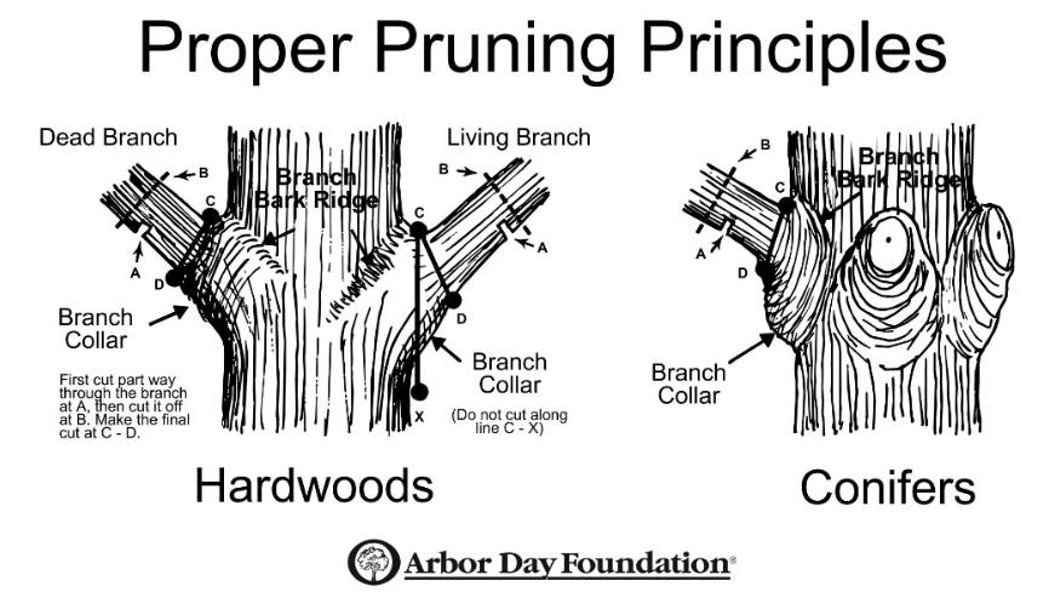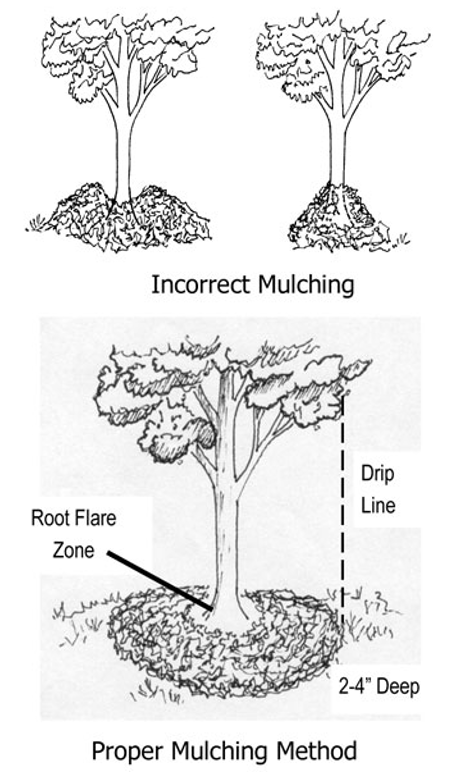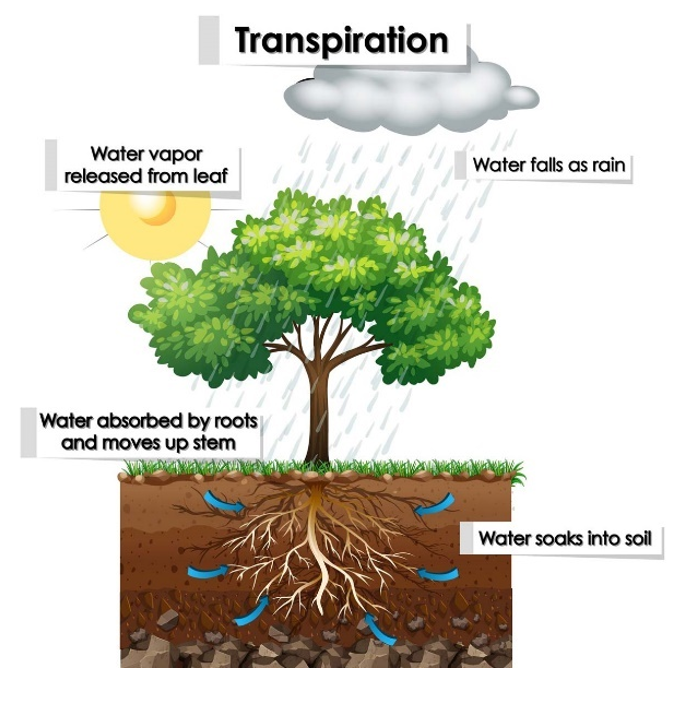Proper Tree Care Practices
Utilizing ISA’s Best Management Practices (BMP), Catawba College will use the following guidelines to ensure the health of campus trees. Members of the campus community, Facilities, the Center for the Environment, and students will work together to learn about and promote growth of strong, healthy trees.
By demonstrating proper tree care practices, the Catawba College Landscape and Grounds Department will work to promote the health and longevity of campus trees.
Pruning Practices
- Pruning should never be performed without a clear objective or outcome such as safety, health, and aesthetics.
- When removing branches, the pruning cut shall not damage the branch bark ridge and branch collar. A proper cut begins just outside the branch bark ridge and angles down away from the stem of the tree, avoiding injury to the branch collar.
- Thinning shall be performed to remove dead, diseased, dying, and defective
- branches, which reduces hazards, promotes health, and improves appearance.
- Thinning shall be performed to reduce the density of branches, to promote light penetration and improve visibility.
- No more than one-quarter of the living crown of a tree will be removed at one time. If it is necessary to remove more, it will be done over successive years.
Raising and Thinning of Branches
Performed to:
- Provide vertical clearance from way of passage, signs, streetlights, and structures
- Maintain live branches by at least two-thirds of a tree’s total height
- Remove all adventitious shoots
Cultural Practices
1) Mulching
The application of mulch to the base of a tree will contribute to tree health. Mulching insulates the roots providing a buffer from extreme weather, retains water, reduces weeds, and prevents compaction and damage caused by grounds maintenance equipment. The College will mulch on a yearly basis and on an as needed basis. The College will use double ground hardwood mulch.

2) Irrigation
New tree plantings will be hand watered from a mobile water tank that collects water through the College’s 275-gallon rain barrel system located within the Landscape and Grounds Department. Although time consuming, hand watering or spot watering is very water wise as only the plants that need water receive water rather than the entire surrounding landscape. A slow-release watering bag such as a TreeGator will be considered for all tree plantings and used if weather conditions warrant it.

3) Fertilization
No regular fertilization schedule is currently in place for trees on campus. However, many trees across campus receive fertilization and lime treatments during fall and spring. Soil samples are taken throughout the campus to determine the proper nutrient needs. Individual trees will be addressed if severe nutrient deficiencies are diagnosed.
- Pest Management
Trees are treated on an as needed basis.
- Transplanting
Desirable trees in an area being developed or other construction sites shall be transplanted by staff if the tree caliper is between 2” ‐ 4” where there is an acceptable location and during the planting season (October to March). An outside contractor will be consulted regarding trees of larger caliper.
Other Cultural Practices
1) Tree Removal
Live trees are generally removed only when required to protect the public’s safety or when detracting from the quality of the landscape. Trees may only be removed after consultation with the Tree Care Advisory Committee where the Committee reaches a consensus. Where the Committee cannot reach a consensus, an outside assessment by a qualified arborist may be required and submitted to the Committee for review.
Diseased trees are generally treated where the possibility of recovery is reasonable. Should the disease be irrecoverable, the tree will be removed for the public’s safety.
A tree that is removed shall be replaced with the same species in the same location when appropriate if 1) The stump can be removed to the extent necessary to replant. 2) There are no utility or location conflicts. 3) The species is not on the list of Prohibited trees. 4) No soil disease caused the death of the removed tree.
Notification – In the event that a large tree or heritage tree needs to be removed, the campus community will be notified via a broadcast e-mail that includes reasons for removal and a photo of the tree.
Planting and Tree Selection
 Recommended Trees are trees that are either native or are non-native and ornamental species and cultivars that are non-invasive.
Recommended Trees are trees that are either native or are non-native and ornamental species and cultivars that are non-invasive.
Consideration of site, cultural requirements, and climate change resilience should be considered when selecting trees. Please refer to Attachment 1 for list of recommended and prohibited trees provided by the Tree Care Advisory Committee with consultation from a local arborist and master gardener.
The planting hole should be dug no deeper than the root ball when measured from the bottom of the root ball to the trunk flare. If the hole is deeper than the root ball, it often results in the settling of the plant above the trunk flare and structure roots which can result in the root ball being planted too deep. The width of the hole should be at least 2 times the diameter of the root ball with sloping sides. All exposed burlap or wire from the root ball should be properly covered or removed. Newly planted trees must receive adequate water weekly during the entire first growing season right up until dormancy in the fall, by irrigation or placement of TreeGator or hand watering.
Tree Damage Assessment – Vandalism and Construction Damage
In accordance with North Carolina General Statutes Chapter 14, Article 22, Section 14-128, Injury to trees, crops, lands, etc., of another.
“Any person, not being on his own lands, who shall without the consent of the owner thereof, willfully commit any damage, injury, or spoliation to or upon any tree, wood, underwood, timber, garden, crops, vegetables, plants, lands, springs, or any other matter or thing growing or being thereon, or who cuts, breaks, injures, or removes any tree, plant, or flower, shall be guilty of a Class 1 misdemeanor: Provided, however, that this section shall not apply to the officers, agents, and employees of the Department of Transportation while in the discharge of their duties within the right-of-way or easement of the Department of Transportation.”
Catawba College has security on staff 24 hours a day, 7 days a week. Surveillance cameras are located all around the campus and are monitored by campus security. Causing damage to campus trees could be subject to an arrest.
Catastrophic Events
Storm response and recovery are generally accomplished in-house. In a crisis, the first priority is to remove tree debris that blocks campus ways of passage, disrupts campus operations, or poses hazards to the campus community. As the tree planting budget permits, lost trees are strategically replaced to restore the structure and function of the campus urban forest in a reasonable time frame. During storm response and recovery, trees requiring specialized equipment not available in-house are addressed by an outside contractor.
